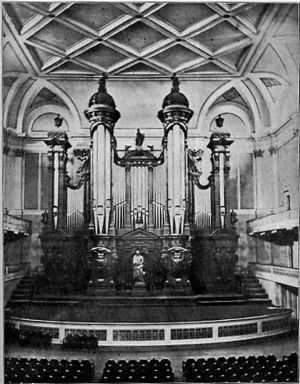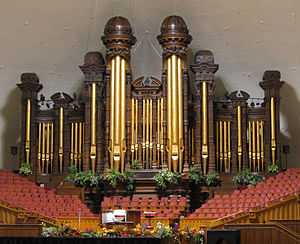Salt Lake Tabernacle organ
The Salt Lake Tabernacle organ is a pipe organ located in the Salt Lake Tabernacle in Salt Lake City, Utah. Along with the nearby Conference Center organ, it is typically used to accompany the Mormon Tabernacle Choir and is also featured in daily noon recitals. It is one of the largest organs in the world.
Construction

The Boston Music Hall Organ
[1]The Tabernacle organ is considered to be one of the finest examples of the American Classic style of organ building.[2][3] Inspired by the design of the Boston Music Hall organ, the original organ was built in 1867 by an Englishman, Joseph Ridges. Ridges' instrument contained some 700 pipes and was constructed of locally derived materials as much as possible. The pipes are constructed of wood, zinc, and various alloys of tin and lead. When it was initially constructed, the organ had a tracker action and was powered by hand-pumped bellows; later it was powered by water from City Creek. Today it is powered by electricity and has an electro-pneumatic action.
Though the organ has been rebuilt and enlarged several times since 1867, the original, iconic casework and some of Ridges' pipes still remain in the organ today.[4] The current organ is largely the work of G. Donald Harrison of the former Aeolian-Skinner organ firm. It was completed in 1948 and contains 11,623 pipes, 147 voices (tone colors) and 206 ranks (rows of pipes).[4]
Uses
The organ often accompanies the Mormon Tabernacle Choir during its weekly radio and television broadcasts of Music and the Spoken Word. It also appears in other concerts, recitals, and in recordings. The Church of Jesus Christ of Latter-day Saints used the organ to accompany music for its semiannual general conferences until April 2000, when the church opened its newly constructed Conference Center across the street to the north, which has its own 7708-pipe organ.
Apart from its use by Mormon Tabernacle Choir's organists, several guest artists have been invited to play the instrument, including Gillian Weir (2007) and Felix Hell (2008).
List of stops
I Choir
|
| Gamba | 16′ |
| Principal | 8′ |
| Concert Flute | 8′ |
| Viola | 8′ |
| Viola Celeste | 8′ |
| Dulcet II | 8′ |
| Kleine Erzähler II | 8′ |
| Prestant | 4′ |
| Zauberflöte | 4′ |
| Gambette | 4′ |
| Piccolo Harmonique | 2′ |
| Fife (Carillon) | 1′ |
| Sesquialtera (Carillon) II |
| Carillon III |
| Rauschpfeife III |
| Dulzian | 16′ |
| Trompette | 8′ |
| Krummhorn | 8′ |
| Orchestral Oboe | 8′ |
| Rohr Schalmei | 4′ |
| Tromp. Harm. (Bomb.) | 8′ |
|
| Tremulant |
I Positiv
|
| Principal | 8′ |
| Cor de Nuit | 8′ |
| Quintade | 8′ |
| Principal | 4′ |
| Nachthorn | 4′ |
| Nazard | 2 2/3′ |
| Principal | 2′ |
| Spillflöte | 2′ |
| Tierce | 1 3/5′ |
| Larigot | 1 1/3′ |
| Sifflöte | 1′ |
| Septerz II |
| Scharf III |
| Zimbel III |
| Rankett | 16′ |
| Cromorne | 8′ |
|
| Tremulant |
|
II Great
|
| Subprincipal | 16′ |
| Quintaton | 16′ |
| Principal | 8′ |
| Diapason | 8′ |
| Montre | 8′ |
| Bourdon | 8′ |
| Spitzflöte | 8′ |
| Flûte Harmonique | 8′ |
| Bell Gamba | 8′ |
| Grosse Quinte | 5 1/3′ |
| Principal | 4′ |
| Octave | 4′ |
| Koppelflöte | 4′ |
| Flûte Octaviante | 4′ |
| Gemshorn | 4′ |
| Grosse Tierce | 3 1/5′ |
| Quinte | 2 2/3′ |
| Super Octave | 2′ |
| Blockflöte | 2′ |
| Tierce | 1 3/5′ |
| Septieme | 1 1/7′ |
| Acuta III |
| Full Mixture IV |
| Fourniture IV |
| Kleine Mixtur IV |
| Cornet V |
| Double Trumpet | 16′ |
| Trumpet | 8′ |
| Clarion | 4′ |
|
III Swell
|
| Lieblich Gedeckt | 16′ |
| Gemshorn | 16′ |
| Geigen Principal | 8′ |
| Gedeckt | 8′ |
| Claribel Flute | 8′ |
| Flauto Dolce | 8′ |
| Flute Celeste | 8′ |
| Viole de Gambe | 8′ |
| Viole Celeste | 8′ |
| Orchestral Strings II | 8′ |
| Salicional | 8′ |
| Voix Celeste | 8′ |
| Prestant | 4′ |
| Fugara | 4′ |
| Flauto Traverso | 4′ |
| Nazard | 2 2/3′ |
| Octavin | 2′ |
| Hohlflöte | 2′ |
| Cornet III |
| Cymbale IV |
| Plein Jeu IV (from Plein Jeu VI) |
| Plein Jeu VI |
| Contra Fagot | 32′ |
| Contre Trompette | 16′ |
| 1ere Trompette | 8′ |
| 2eme Trompette | 8′ |
| Hautbois | 8′ |
| Voix Humaine | 8′ |
| Quinte Trompette | 5 1/3′ |
| Clairon | 4′ |
|
| Tremulant |
|
IV Bombarde
|
| Diapason | 8′ |
| Octave | 4′ |
| Grosse Cornet IV–VI |
| Grande Fourniture VI |
| Bombarde | 16′ |
| Trompette Harmonique | 8′ |
| Trompette | 8′ |
| Clairon | 4′ |
IV Solo
|
| Flauto Mirabilis | 8′ |
| Gamba | 8′ |
| Gamba Celeste | 8′ |
| Concert Flute | 4′ |
| Nazard | 2 2/3′ |
| Piccolo | 2′ |
| Tierce | 1 3/5′ |
| French Horn | 8′ |
| English Horn | 8′ |
| Corno di Bassetto | 8′ |
| Tuba | 8′ |
| Cornet V (Great) | 8′ |
| Harp | 8′ |
| Chimes |
| Celesta (Harp) |
|
| Tremulant |
V Antiphonal
|
| Diapason | 8′ |
| Gedeckt | 8′ |
| Salicional | 8′ |
| Voix Celeste | 8′ |
| Principal | 4′ |
| Kleine Mixtur III |
| Trompette | 8′ |
| Vox Humana | 8′ |
| Tuba Mirabilis | 8′ |
| Cornet (Great) V |
|
| Tremulant |
Percussion
|
| Chimes on Great |
| Chimes on Pedal |
| Harp on Choir |
| Celesta on Choir |
|
Pedal
|
| Montre | 32′ |
| Flûte Ouverte | 32′ |
| Contre Bourdon | 32′ |
| Principal | 16′ |
| Flûte Ouverte | 16′ |
| Contre Basse | 16′ |
| Violone | 16′ |
| Bourdon | 16′ |
| Gemshorn (Swell) | 16′ |
| Gamba (Choir) | 16′ |
| Lieblich Gedeckt (Swell) | 16′ |
| Grosse Quinte | 10 2/3′ |
| Principal | 8′ |
| Violoncello | 8′ |
| Spitzprincipal | 8′ |
| Flûte Ouverte | 8′ |
| Flauto Dolce | 8′ |
| Gamba (Choir) | 8′ |
| Lieblich Gedeckt (Swell) | 8′ |
| Quinte | 5 1/3′ |
| Choral Bass | 4′ |
| Nachthorn | 4′ |
| Gamba (Choir) | 4′ |
| Lieblich Gedeckt (Swell) | 4′ |
| Principal | 2′ |
| Blockflöte | 2′ |
| Full Mixture IV |
| Cymbale IV |
| Grand Harmonics V |
| Bombarde | 32′ |
| Contra Fagot (Swell) | 32′ |
| Ophicleide | 16′ |
| Trombone | 16′ |
| Double Trumpet (Great) | 16′ |
| Contre Tompette (Swell) | 16′ |
| Dulzian (Choir) | 16′ |
| Posaune | 8′ |
| Trumpet | 8′ |
| Double Trumpet (Great) | 8′ |
| Contre Trompette (Swell) | 8′ |
| Krummhorn (Choir) | 8′ |
| Clarion | 4′ |
| Chalumeau | 4′ |
| Kornett | 2′ |
|
References
- ↑ Elson, Louis Charles (1904). The History of American Music: With Twelve Full Page Photogravures and One Hundred and Two Illustrations in the Text. New York: Macmillan Co. p. 188. OCLC 55551750.
- ↑ Bethards, Jack: "The 1988 Renovation—A Builder's Perspective" The American Organist Vol. 22, no. 12 (December 1988), p. 71.
- ↑ Owen, Barbara (1990). The Mormon Tabernacle Organ: An American Classic. The American Classic Organ Symposium. Salt Lake City: The Church of Jesus Christ of Latter-day Saints. ISBN 1-55517-054-4.
- ↑ 4.0 4.1 11,623 Pipes: The Story of the Tabernacle Organ, Tabernacle Choir Website. Retrieved on September 28, 2007.
Further reading
- Bethards, Jack M. (1992), "Tabernacle Organ", in Ludlow, Daniel H., Encyclopedia of Mormonism, New York, NY: Macmillan, pp. 1434–36, ISBN 0-02-904040-X, OCLC 24502140 .
- "Church of Jesus Christ of Latter-day Saints: The Mormon Tabernacle Salt Lake City, Utah". American Organist (New York: American Guild of Organists) 22: 56–82. December 1, 1988. ISSN 0164-3150.
- "The Great Tabernacle: A Building of Purpose and Spirit". Ensign 37 (4): 24–31. April 2007.
- Longhurst, John; Newell, Lloyd D. (2000). "Tabernacle Organ". In Garr, Arnold K.; Cannon, Donald Q.; Cowan, Richard O.. Encyclopedia of Latter-day Saint History. Salt Lake City, Utah: Deseret Book. p. 1214. ISBN 1-57345-822-8.
- McDonald, Donald Gordon (1952). The Mormon Tabernacle Organ. Master's thesis. New York: Union Theological Seminary.
- Owen, Barbara (1990). The Mormon Tabernacle Organ: An American Classic. The American Classic Organ Symposium, Temple Square. Salt Lake City, Utah: The Church of Jesus Christ of Latter-day Saints. ISBN 1-55517-054-4.
- Todd, Jay M. (April 1967). "Tabernacle Organ". Improvement Era 70 (4): 14–20.
- Walker, Ronald W. (2007). "World-Famed Organ". Pioneer (Salt Lake City: Sons of Utah Pioneers) 54 (2): 21. ISSN 0554-1840.
External links
|
|---|
| | Northeast | |
|---|
| | Midwest | |
|---|
| | West | |
|---|
| | Non-U.S. | |
|---|
|


 Media related to Salt Lake Tabernacle organ at Wikimedia Commons
Media related to Salt Lake Tabernacle organ at Wikimedia Commons